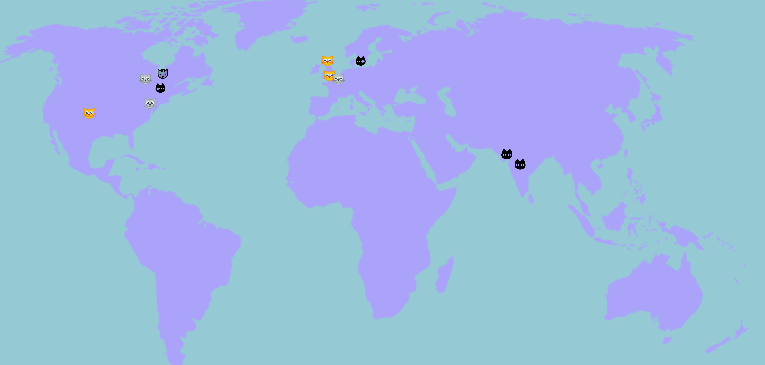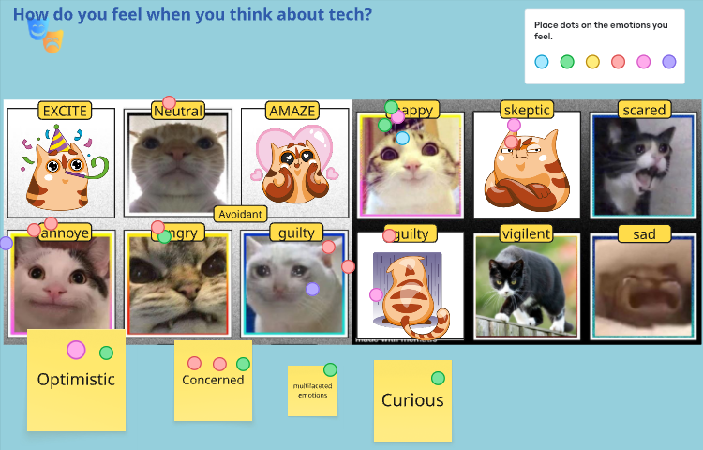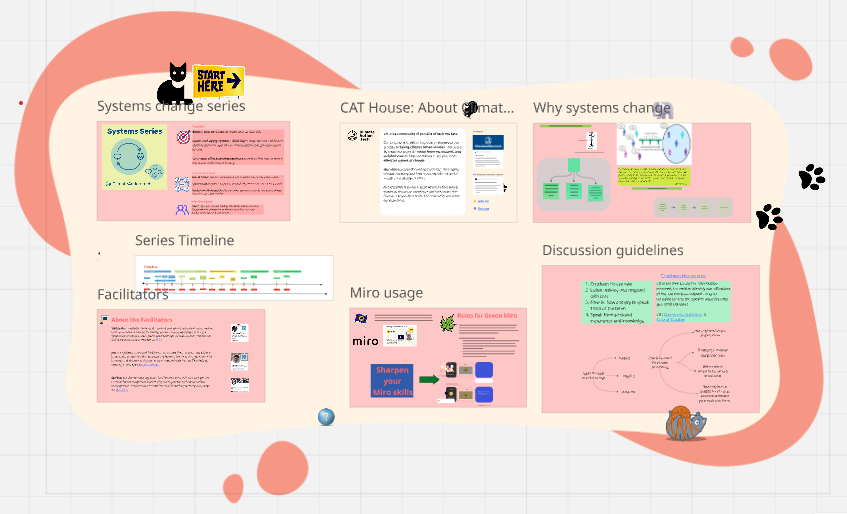The Systems Change for Sustainable Tech is a 3-part co-creation series that invites everyone who is interested to use systems thinking to build a sustainable tech future. Together, we will envision a sustainable future for technology, map our current situation using systems maps (causal loop diagrams), identify key leverage points for impactful change, design effective interventions, and create action plans to bridge the gap between our vision and today’s reality. This article is the recap of the first part that would help you to participate in the second part of the series.
To join the second session, Mapping the Current Reality, RSVP on Luma.
On Thursday, May 22nd, thirteen systems change makers gathered for the inaugural event of the systems series called Systems Change for Sustainable Tech. Participants were introduced to the program’s vision, the fundamentals of Miro for newcomers, and established a foundation of respectful dialogue guided by Chatham House rules and Otto Sharmer’s four levels of listening. The series aims to unlock pathways for social and systemic change through inquiry, empathy, and genuine connection.
We began by having everyone introduce themselves on a collaborative Miro board. A review of the registration questionnaire results (collected via Luma) revealed a shared curiosity about systems thinking, a desire for collaboration and community building, and a strong eagerness to share ideas and contribute. Fortunately, most participants were already comfortable navigating Miro.

Getting to know each other
The audience was diverse, representing perspectives from across the globe, particularly from the US, Canada, Europe, and India. A playful exercise, virtually placing cat avatars on a world map, proved a fun way to visually represent this geographical and cultural diversity.

A candid discussion followed, exploring our collective emotional landscape surrounding the current state of technology. Everyone expressed a wide spectrum of feelings – from scepticism and frustration to guilt, happiness, curiosity, and optimism. It was insightful to witness how readily we navigate multiple emotions simultaneously when reflecting on technology, underscoring the importance of understanding these feelings to build a shared vision.

The session then transitioned to exploring the shared vision through four thematic “islands”: Imagining Futures, Value Compass, Indigenous and Generational Wisdom, and Committing to the Creation of This Future. For the first three islands, we engaged in deeper exploration within two breakout rooms in Zoom: Seedling Sanctuary and Forest Futures.

Imagining futures
We began with a moment of mindful reflection, imagining an ideal future, and then dove into a dynamic exploration in breakout rooms. The reason this activity is important is that we are so overwhelmed by current reality that it becomes difficult for us to imagine an ideal tech future. Imagining gives us hope.
Across both groups, a consensus emerged: technology must be a tool, not a ruler. We imagined a world where decision making amplified human capabilities rather than replacing them.
Key themes included a strong emphasis on democratization of tech, access for all, not just the privileged. Everybody envisioned technology as a “technical commons,” shared resources like cars and datacenters, with open-source collaboration taking precedence over competition. It was interesting to see that in both the rooms, we imagined a universe similar to Star Trek that focused on public good and equal access.
Ethical considerations were paramount, with a call for embedded laws and ethical AI principles to guide development and ensure technology serves the wellbeing of people, where transparency acts as a “guardrail” for good decision-making.
But the vision extended beyond purely digital solutions. We connected technological progress with genuine sustainability, not just environmental, but community-focused. Ideas like biomimicry, technology inspired by natural solutions, and fully recyclable prospered in this future.
Value compass
Following the initial envisioning phase, we turned our attention to the “Value Compass” island, a space dedicated to identifying the guiding principles for a positive technological future. The discussion centered around four key questions: What principles should guide our actions? What values create a just world? How can these values inspire tech to work for the planet? And, crucially, how do we sustain this vision?
From this exploration emerged a variety of values. We emphasized actions that foster environmental wellbeing and a fundamental commitment to fairness, ensuring technology enables and includes all, rather than creating further barriers. The need for robust ethical guidelines within companies and effective regulation was repeatedly highlighted.
Several of us articulated a desire for a return to connection, with nature, with community, and with each other. This led to ideas like gamifying local improvements (e.g., community park building), prioritizing open communication and transparency, and fostering a “scientific temper” through tech and AI awareness education. The importance of environmental impact labeling and holistic solutions addressing systemic issues were also emphasized, alongside a focus on overall wellbeing.
A recurring thread was the need to move beyond traditional hierarchical structures towards more distributed and collaborative models: valuing free association, quality of life, empathy, and kindness. Participants stressed the importance of repairing existing technologies, valuing what we already have, and embracing open-source principles. They also advocated for a shift from relentless pursuit of growth to a more measured approach: “Slow is smooth & smooth is fast.”
Interestingly, the “Forest Futures” breakout room organized these values into broader categories: connection (humans, tech, community, environment), quality of life (not just growth), relationship living, and corporate sustainability.
The group also proactively identified principles to avoid or approach with nuance, including hyper-individualism, colonialism and imperialism, the over-quantification of everything, the pursuit of efficiency and growth at all costs, and the potential for Jevons paradox (where increased technological efficiency leads to increased consumption). This discussion underscored a commitment to building a future grounded not just in aspirational values, but also in a critical awareness of potential pitfalls.
Indigenous and generational wisdom
The “Indigenous and Generational Wisdom” island proved to be the most emotionally resonant part of our workshop, prompting a powerful reflection on how far we’ve drifted from sustainable ways of life practiced by previous generations. Participants grappled with the challenges of reclaiming that wisdom in a world dominated by rapid technological advancement.
The discussion revolved around fundamental questions: What stories do we want to pass on to the future? How can we learn from the past to build more ethical technology? How did indigenous wisdom historically protect nature? And, crucially, how can we ensure indigenous voices are included in the design and deployment of new technologies?
A common thread emerged across both the groups: a yearning for the careful resourcefulness of grandparents, who lived with less, minimized waste, and deeply valued the impact of new technologies. Participants shared poignant memories: a grandmother skillfully using her first camera, the excitement of a community gaining electricity, and the ingrained habit of conserving energy.
The group acknowledged the stark contrast between these mindful practices and our current culture of overconsumption and disposability. One change maker stated that “technology has become like alcohol,” hinting at its addictive potential and detrimental effects. We hoped for a future where technology is not addictive and would be used only when needed.
Drawing inspiration from organizations like Survival International, the conversation turned to the critical role of indigenous knowledge in conservation. Participants emphasized the proven effectiveness of indigenous-led conservation efforts, noting that “Indigenous people are the world’s best conservationists.”
The value of reconnecting with ancestral practices resonated deeply. This included generational ideas like ‘longtermism’ or seven generations stewardship which asserts that important decisions should take into account the consequences for future generations as far into the future as seven generations. It also included concepts that our indigenous heritage has long valued. Examples like the importance of biodiversity, the circularity of life (which includes death) and remembering to ‘feed the hand that feeds you’.
Key themes included:
- Respect for the land: Fostering a relationship with the land and mimicking natural systems.
- Circular thinking: Embracing the full life cycle of tech products.
- Ethical principles: Reclaiming values like non-violence, truthfulness, and non-attachment for the common good.
- Long-term vision: Adopting a “7 Generations” philosophy, considering the impact of our actions on future descendants.
- Regenerative practices: Moving beyond sustainability to actively restore ecosystems.
- Indigenous sovereignty: Acknowledging the importance of “LAND BACK” and centering indigenous voices in decision-making.
Participants also highlighted the importance of historical awareness, respecting past knowledge, and recognizing that “nature is the best teacher.” This island served as a reminder that building a truly sustainable future requires not only technological innovation but also a deep respect for the wisdom of those who came before us.
Commitment to creating this future
The final island of our workshop, “Commitment to Creating This Future,” served as a powerful call to action. Systems change makers translated the collective vision into individual promises–concrete steps they would take to contribute to a more just, sustainable, and ethical technological landscape.
The promises reflected a diverse range of actions, encompassing individual habits, professional endeavors, and advocacy efforts.
Key themes emerged:
- Promoting justice & equity: A commitment to making technology more just and accessible to all.
- Advocating for sustainability: Engaging with industry leaders to champion sustainability within the tech sector.
- Empowering responsible business: Supporting others in creating responsible and sustainable digital businesses.
- Rejecting dominant platforms: Actively reducing reliance on large tech corporations (“getting off of big tech platforms,” “degoogle all the things”).
- Open source by default: Prioritizing open-source solutions by default.
- Raising awareness & promoting systems thinking: Utilizing systems thinking to make technology more sustainable and spreading awareness about tech and AI.
- Sharing alternatives & inspiring new perspectives: Actively sharing alternative technologies and ways of thinking.Maintaining vision & hope: Continuing to envision and inspire a more positive future.
These commitments, while individually expressed, collectively represent a powerful force for change, a willingness to actively shape a future where technology serves humanity and the planet, rather than the other way around. They underscore the belief that building a better future is not simply a matter of technological innovation, but of conscious choice, collective action, and active hope.
Systems Series 2: Systems thinking to map the current reality
Many discussions around technology focus on what is happening: new devices, app updates, or reports of environmental damage (these are events). But to truly address the root causes, we need to understand why these events occur. The second part of the systems series is a chance to actively build a shared understanding of the systemic forces driving unsustainable tech, together.
During this 90-minute co-creation session, we will:
- Explore the iceberg model: We’ll use this framework to collaboratively identify the different levels of a system–from visible events, to patterns of behavior, to underlying structures, and finally, the deeply held mental models that shape our actions.
- Co-create causal loop diagrams: Working together, we’ll map the complex relationships within the tech ecosystem using causal loop diagrams.
- Surface & discuss mental models: We’ll identify and discuss the often-unconscious beliefs and assumptions that drive the development and adoption of unsustainable technologies.
Systems thinking isn’t just about understanding problems, it’s about identifying leverage points, places where collective action can have significant positive impact. By building a shared system map, we can move beyond treating symptoms and begin to uncover opportunities for meaningful change.
If you want to participate in understanding the current reality with other CAT change makers, you can register for the Systems Series 2 workshop happening on Thursday, June 5. If you can’t attend, you can keep contributing to the series by putting your thoughts on Miro and participate in discussions in the #systems-series CAT Slack community channel.
Let’s continue to envision a sustainable tech future and map the current reality using systems thinking.
Acknowledgements: A special thank you to Jon Sleeper for generously agreeing to co-facilitate the workshop with very little notice. His coaching expertise was instrumental in making the workshop even more impactful. I would also like to express my sincere appreciation to Melissa Hsiung for her help with the series planning.
